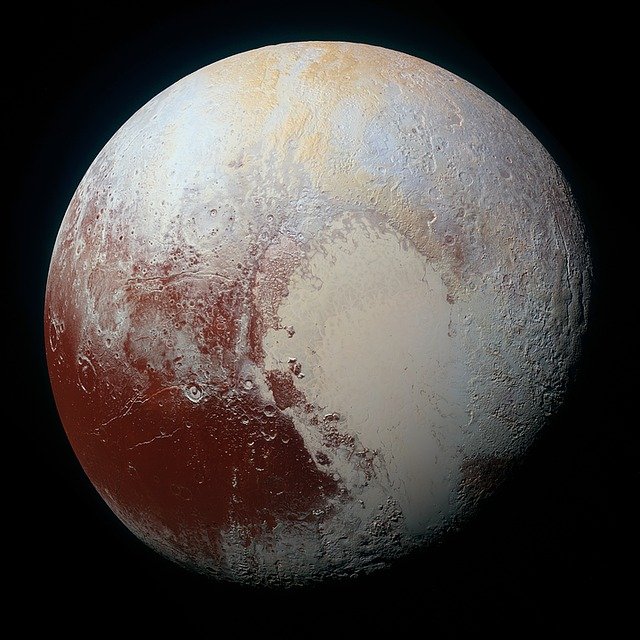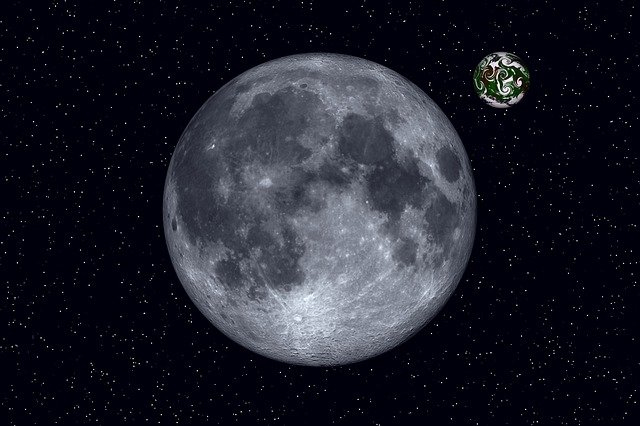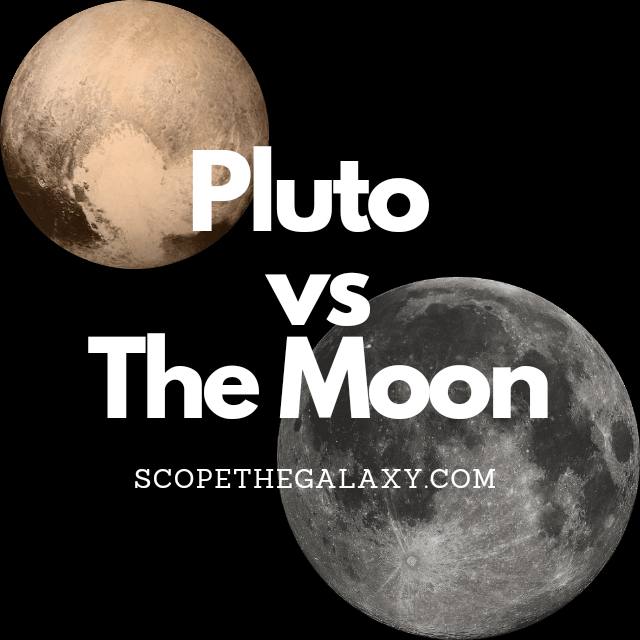*This post may contain affiliate links. This means we may make a commission if you purchase an item using one of our links*
The main differences between Pluto and the Moon are that Pluto is a dwarf planet that has 5 natural satellites orbiting it whilst the Moon is Earth’s natural satellite, the Moon has practically no atmosphere whilst Pluto does, the Moon is also the bigger of the two with a diameter of 3,474.8km as opposed to the 2,370km diameter of Pluto.
There are other differences between Pluto and the Moon so continue reading if you want a more thorough breakdown of the similarities and differences between the two.
What Is The Planet Pluto?
Table of Contents

In the past Pluto was the 9th farthest official planet in our solar system however, in 2006 after many debates between astronomers, the International Astronomical Union officially downgraded it to a dwarf planet.
The reason for this downgrade at the time was primarily down to Pluto simply being too small when compared to every other planet and even the moons orbiting these planets. Pluto’s dwarf status is still debated to this day but, for now it remains under this dwarf bracket for a planet
Its diameter for example is only 2,370km, which is a third of Earth’s Moon. With that being said, despite the significant size discrepancy Pluto shows, it still does have more moon like objects orbiting it than Earth and I’m not saying just one more.
In total this terrestrial dwarf planet has 5.
Pluto’s atmosphere consists mostly of molecular nitrogen whilst molecules of methane and carbon monoxide have been observed also. As for its surface, it consist mostly of frozen nitrogen, methane, and carbon monoxide ices.
One of Pluto’s most unique characteristic is that Charon (its largest moon) is tidally locked to it and vice versa, which means that the two essentially orbit each other where, in essence only one side of Charon and one side of Pluto’s surface will face each other at any given time.
Pluto’s temperature is between -222 to -232 degrees Celsius based on how close it gets to the Sun when orbiting it, whilst its core temperature isn’t anything too special sitting around 500 – 1,000 degrees Celsius.
The main reason it’s as cold as it is and has a relatively cold core in comparison to the other planets would be mostly down to its size. A larger size would mean more mass could be compressed at the center which would produce more heat at the core.
Pluto’s orbit is also different from the other main plants in our solar system, following an elliptical orbital path as opposed to the circular path the others take. As a result of its distance from the Sun, Pluto will complete each one of these elliptical cycles around the Sun once every 247.78 years.
Even its rotational cycle is very slow, where one cycle is completed in 157 hours. Another interesting fact is the Pluto’s axial tilt is almost on its side at 57 degrees, similar to Uranus.
What Is The Moon?

The Moon is the gray celestial being that orbits our Earth. It is also tidally locked to Earth meaning that we only see one side of it at any given time across our skyline.
It takes the moon roughly 27 days to complete an orbit around Earth, which it does in an elliptical pattern. The Moon’s axial tilt is very straight at 1.5 degrees. As a result of the tidally locked status along with the effects that Earth has on Its general rotational patterns, it takes the Moon roughly 29.5 days to complete a day.
In regards to its temperature, it fluctuates where it can be really hot at 127 degrees Celsius when the Sun is shining on it and as low as -173 degrees in areas where the Sun does not strike it. It’s core on the other hand is far hotter ranging between 1,327 to 1,427 degrees Celsius.
This is as a result of the lunar entity’s extremely thin to practically non-existent atmosphere, which not only results in these massive temperature shifts but, is also the reason why it has over 100,000 craters on its surface.
Speaking of the Moon’s surface, the entity is mostly made of rocks, iron, magnesium much like most of the other moons and terrestrial based planets in our solar system.
It is among the bigger moons in our solar system with a diameter of 3,474.8km and a mass of 7.35 × 10^22 kg, which actually places it fifth amongst all moons in our solar system and would also make it bigger than the dwarf planet Pluto.
Despite all the advancements in technology, the last time a manned mission was made to the Moon was on the Apollo 17 way back in December 1972 and no further missions have been done since, possibly as result of the political agendas behind the numerous countries vying for opportunities that involve the Moon that we don’t know of.
How Are The Moon And Pluto Similar?
Although Pluto and our Moon don’t share too much in common, there are the odd few similar features, which in this case include the following:
- Both have a hotter central core.
- Both orbit their central bodies in an elliptical pattern.
- Both have a rocky, terrestrial surface.
- Both are spherical in shape.
- Neither have rings surrounding them.
- Both are tidally locked to another celestial body.
Differences Between The Moon And Pluto
As for the differences between the two they include the below:
- The Moon is a satellite that orbits Earth whilst Pluto is a dwarf planet that other space objects orbit.
- Pluto is smaller that the moon with a diameter of 2,370km which is roughly a third smaller than the Moon’s diameter of 3474.8km.
- Pluto has 5 moons orbiting it whilst the Moon has 0.
- Pluto is colder than the Moon on average as it can hit low temperatures between -222 to -232 degrees Celsius as opposed to the moon that can range from as hot as 127 degrees Celsius to lows of -173 degrees Celsius.
- As for their Core temperatures, the Moon’s is hotter ranging between 1,327 – 1,427 degrees Celsius as opposed to Pluto’s that ranges between 500 – 1,000 degrees Celsius.
- The moon is a dark gray color although it can appear as a brown tinged gray depending on how the sun shines on it. Pluto is a mixture of colors form red, gray and blue.
- Pluto orbits the Sun whilst the Moon orbits the Earth. It takes the Moon only 27 days to orbit the Sun whilst it takes Pluto 247.78 years to orbit the Sun.
- The Moon also has a longer day than Pluto where a single rotation around its axis can take 29.5 days as opposed to Pluto that completes a day in 157 hours.
- As for each bodies axial tilt, the Moon is practically straight with a tilt of 1.5 degrees to the right whilst Pluto’s is more distinct at 58 degrees to the right.
- The Moon has practically no atmosphere whilst Pluto does have a more noticeable atmosphere.
- Pluto is the lighter of the two with a mass of 1.31 × 10^22 kg whereas the Moon’s mass is 7.35 × 10^22 kg.
Summary
Although both have their fair share of similarities from how they orbit their primary body and their general rocky composition, they differ in many other ways also.
This could include their differences in size, temperature, the length of their days and beyond. In the end of the day one is simply a natural satellite whilst the other is a dwarf planet with many natural satellites orbiting it therefore, at the very least they are distinct in terms of how they affect their surroundings



I surmise that pluto and Cheron are moons, (from a sister planet,) that yet to show
it’s self (or maybe a gravity field of enegery, that’s not visible to our tech as of yet,